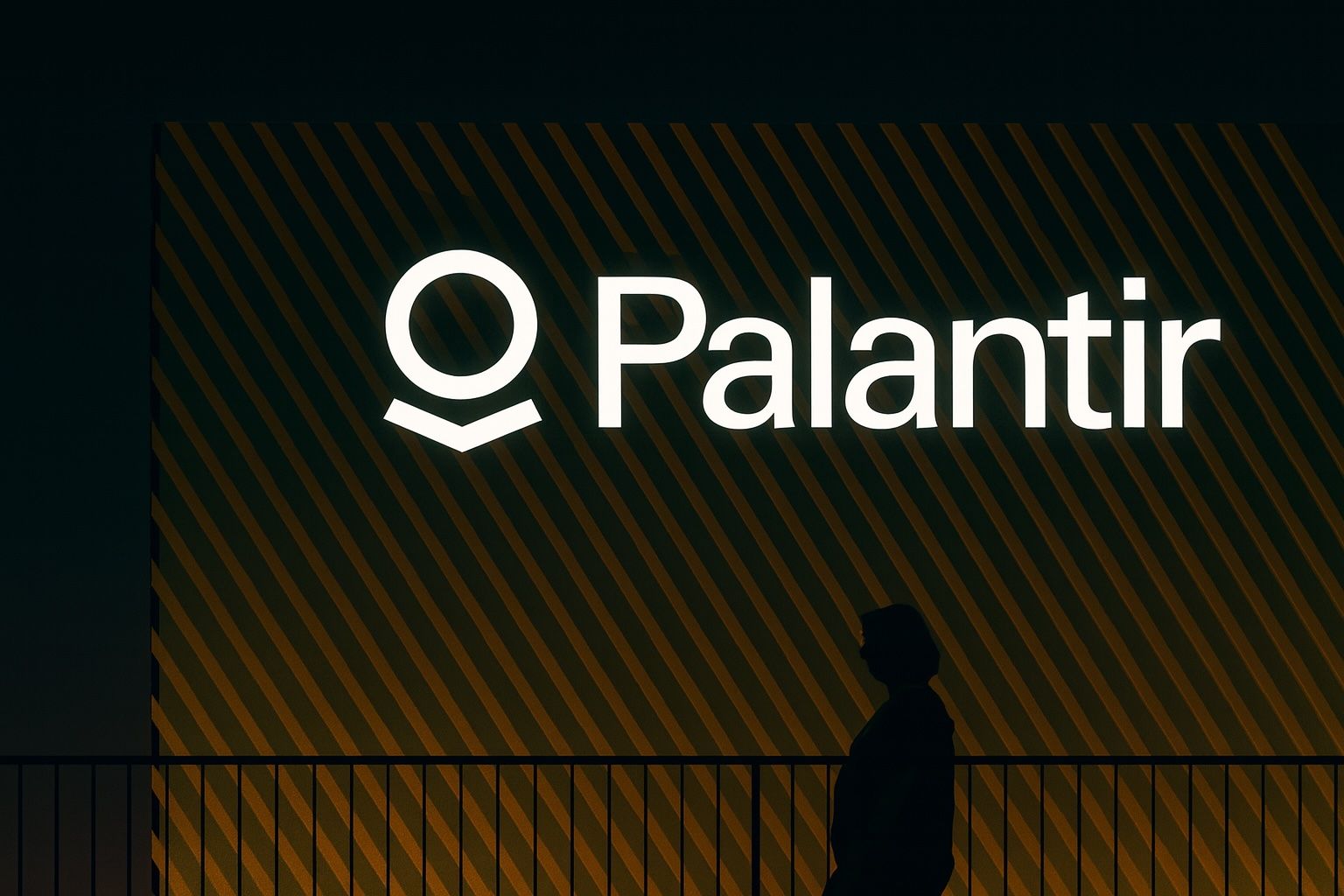- Soaring Stock: Palantir Technologies (PLTR) has skyrocketed roughly 130–140% year-to-date in 2025, making it one of the top-performing S&P 500 stocks for a second straight year [1]. The stock is up ~360% over the past 12 months and an astounding >1,800% since its 2020 IPO [2].
- Record Earnings: Palantir’s Q2 2025 results were a blowout, with revenue hitting $1.0 billion for the first time (up 48% YoY) and GAAP net income solidly positive. Management raised full-year revenue guidance to $4.14–4.15 billion amid robust government and commercial demand [3]. Profitability and free cash flow are strong, and the company’s “Rule of 40” growth+margin metric is well above industry norms [4].
- Big Deals Galore: Major contracts are propelling Palantir’s growth. In July 2025, the U.S. Army consolidated dozens of projects into a single enterprise deal with Palantir – an agreement valued up to $10 billion over 10 years (an IDIQ contract signaling the Army’s deepening reliance on Palantir’s software) [5]. In September, the U.K. government announced a £1.5 billion (≈$1.8B) defense partnership to deploy Palantir’s AI technology across British military operations [6]. Palantir is also expanding in the private sector: Boeing’s Defense unit will integrate Palantir’s AI/data platform across its production lines, a “game-changing” move according to Boeing’s defense chief, which helped bump PLTR shares ~2% on that Sept 23 news [7].
- Army Memo & Stock Volatility: An internal U.S. Army memo leaked in late September raised alarms about “fundamental security” flaws in a new battlefield network (NGC2) that Palantir and partner Anduril are developing [8]. The memo labeled the system “very high risk,” citing vulnerabilities like lack of access controls and auditing [9]. Palantir’s stock tumbled ~7.5% after this report [10]. However, the Army and companies quickly clarified that the memo reflected an early prototype and that the issues had been addressed as part of the normal testing process [11]. Palantir noted “no vulnerabilities were found in the Palantir platform” and any problems were immediately mitigated [12]. With these reassurances, PLTR rebounded ~3% on October 6 [13] [14], recovering much of the lost ground.
- New AI Partnerships: Palantir continues to extend its reach beyond defense. On Oct 6, 2025, healthcare data firm OneMedNet announced it has chosen Palantir’s Artificial Intelligence Platform (AIP) to power a near real-time analytics network for hospitals and researchers [15]. OneMedNet’s CEO said “Palantir’s AIP helps us revolutionize our ability to deliver high-quality, regulatory-compliant data at remarkable speed,” enabling breakthroughs in AI-driven clinical research [16]. This multi-year partnership aims to tap the $868 billion AI-healthcare market by 2030 with Palantir’s tech [17] [18]. Palantir has also inked deals in energy (an AI “nuclear operating system” project worth $100M [19]) and is deploying its Foundry platform with new enterprise clients (e.g. the UK’s NHS health service and automaker Fiat) as it pivots into sectors like healthcare, automotive, and finance [20].
- Analysts Split on Outlook: Wall Street remains divided on Palantir. Bulls point to Palantir’s meteoric growth and AI leadership, while bears worry the stock is overhyped. Wedbush analyst Dan Ives (a noted tech bull) reiterates Palantir as a top pick, likening the AI boom to an “all-night party” that’s “only at 10:00 p.m. … and [running] to 4:00 a.m.” – i.e. we are still early in an extended AI super-cycle [21]. In contrast, outspoken short-seller Andrew Left (Citron Research) has called Palantir’s valuation “absurd,” arguing the company’s true value should be only ~$65–$70 per share (far below current levels) [22]. Many analysts acknowledge Palantir’s strengths – “dual engines” of government and commercial growth, as DA Davidson’s Gil Luria notes [23] – but remain cautious. Price targets are all over the map: recent 12-month targets span from under $100 up to $215 (Bank of America’s bull case) [24]. The median target lies around $155–165, not far from the current stock price, and the consensus rating is Hold [25] [26].
- AI Dominance… at a Price: Palantir is widely seen as a leader in the AI-driven data analytics and defense tech space. Industry watchers rank it #1 in “decision intelligence” platforms (IDC) and among the leaders in enterprise AI/ML software (Forrester) [27]. Its two-decade head start in big data integration (building deep “ontology” models of data) gives Palantir a competitive moat, especially in handling sensitive, large-scale government datasets [28]. Palantir’s unique positioning as an “AI arms dealer” to both militaries and corporations has fueled its stock surge and a ~$400 billion market cap. However, investors are paying a rich price for this growth: Palantir trades at valuation multiples far above peers. By one estimate, Palantir’s forward price-to-sales is over 110× (versus ~6× for a peer like C3.ai) [29], and its forward P/E tops 210×, dwarfing even other high-flying tech names [30]. This lofty valuation leaves little margin for error – any slowdown or negative surprise (be it contract issues or broader market pullbacks) could trigger a sharp correction. Even some Palantir bulls concede the stock’s momentum must be balanced against its fundamentals. As CNBC’s Jim Cramer mused, Palantir embodies both the AI goldmine excitement and bubble risk of today’s market.
Stock Performance and Momentum (2024–2025)
Palantir’s stock has been on a phenomenal two-year run, minting early investors hefty gains. After surging 373% in 2024, PLTR continued its ascent in 2025, rising roughly 140% year-to-date as of October 6 [31]. This rally has made Palantir one of the S&P 500’s top performers and lifted its market capitalization into the hundreds of billions. In the past year alone, the stock climbed ~363% [32], vastly outperforming the broader market. For context, since its late-2020 IPO (at ~$10/share), Palantir’s stock has appreciated nearly 19× over five years [33] – an almost unheard-of trajectory.
This momentum is driven by euphoria around artificial intelligence (AI) and Palantir’s perceived leadership in that field. Palantir branded itself as the “operating system for the modern enterprise in the era of AI,” and investors have piled in, betting on long-term dominance in AI software. As a result, trading volumes have been high and retail investor buzz is intense – Palantir frequently trends on forums like Reddit and StockTwits. Notably, in late August 2025, PLTR was the #1 trending ticker on StockTwits (even as shares dipped on a short-seller’s attack) [34]. Social media sentiment has swung between FOMO-driven bullishness (“to the moon – $200 soon!”) and skeptical warnings (“this feels like a bubble ready to pop”) [35].
Despite intermittent pullbacks, dip-buyers have repeatedly stepped in, reflecting confidence that Palantir will continue to ride the AI wave. Technically, the stock has shown resilience: even after a late-summer pullback, PLTR found support around its 50-day moving average (~$150) and quickly resumed an uptrend [36]. By early October, shares were flirting with all-time highs near $180. Traders note that momentum remains strong, though some consolidation was expected given the magnitude of year-to-date gains. In short, Palantir’s stock surge in 2025 has solidified its status as a market darling in the AI boom – albeit one with high expectations baked in.
Financials and Recent Earnings
Palantir’s financial performance in 2025 has underscored the company’s rapid growth — and its transition to consistent profitability. In Q2 2025, reported in early August, Palantir delivered stellar numbers: revenue hit $1.004 billion (up 48% year-over-year), marking the company’s first ever billion-dollar quarter [37]. This growth accelerated for an eighth consecutive quarter, a streak of improving top-line expansion [38]. Palantir’s U.S. commercial revenue in particular has inflected sharply thanks to demand for its new AI offerings (jumping +71% YoY in Q1) [39]. The Q2 results also handily beat analyst estimates (Palantir earned $0.16 EPS vs. $0.14 expected, on $1.00B revenue vs. $940M expected) [40].
Crucially, Palantir has achieved what many high-growth tech firms struggle to reach: GAAP profitability. In 2025 it turned the corner to GAAP net income after years of losses, posting a 24% GAAP net margin in Q1 2025 [41]. Operating leverage is improving as well – adjusted operating margins neared 46% in Q2 [42], and free cash flow margins have been running 40%+ [43], indicating Palantir’s software business has inherent profitability once scaled. This combination of high growth + solid margins gives Palantir a phenomenal “Rule of 40” score (growth % + profit %), which reached ~83% in recent quarters [44] – an “extraordinary” level that few peers can match.
Buoyed by these results, Palantir’s management raised guidance. After Q2, the company boosted its full-year 2025 revenue outlook to ~$4.14–4.15 billion [45] (implying ~36% YoY growth) and affirmed it expects to remain profitable each quarter of 2025 [46]. Palantir has in fact upped its 2025 guidance multiple times this year as business momentum built [47]. CEO Alex Karp and team project confidence that demand – especially for the new Palantir Artificial Intelligence Platform (AIP) – is surging and will sustain elevated growth.
On the earnings call, executives highlighted that both government and commercial segments are serving as “accelerants on both sides” of growth [48]. Government revenue (42% of Q2 sales) remains a steady engine, growing as U.S. defense agencies and allies deepen their Palantir usage. At the same time, commercial revenue is re-accelerating with new enterprise clients in energy, healthcare, finance, and more adopting Palantir’s Foundry and AIP software. This dual-engine growth model is somewhat unique – Palantir is monetizing cutting-edge AI in both classified military programs and Fortune 500 boardrooms.
Profitability outlook: Palantir’s CFO has noted the company will continue investing heavily in R&D and hiring (to seize its AI opportunity), which could keep a lid on near-term margins [49]. Nonetheless, thanks to its high gross margins and moderate stock-based compensation (relative to revenue), Palantir is generating healthy cash flow. It ended Q2 with roughly $3 billion in cash and no debt, giving it flexibility to invest or acquire as needed. In short, Palantir’s financial profile in 2025 is marked by breakneck growth, improving profitability, and a war chest to fund expansion – a combination that justifies some of the market’s enthusiasm, though also fueling debate on valuation (discussed further below).
Strategy, Products, and Business Developments
Originally known for its secretive work with U.S. intelligence agencies, Palantir has been broadening its scope and reinventing its image in 2025. The company’s strategy is two-pronged: dominate the defense/government sector (its historical stronghold) and aggressively expand into commercial industries with its data platforms and AI tools.
On the government side, Palantir’s software is now deeply embedded in myriad agencies and military branches. Alongside the landmark U.S. Army enterprise deal (more on that shortly), Palantir has contracts or deployments with the Air Force, Navy, Special Operations Command, CIA, and more [50]. Its software powers mission-critical operations from battlefield intelligence to pandemic response. In fact, the U.S. Department of Defense has increasingly standardized on Palantir’s platforms for data integration and AI – a trend likely to continue, as the current U.S. administration prioritizes defense tech modernization [51]. Internationally, Palantir is also gaining traction: the new UK Ministry of Defence partnership (worth £1.5B) will see Palantir’s tech used across the British armed forces [52], and other NATO allies are reportedly considering similar collaborations.
A recent notable U.S. Army deal came in late July 2025, when the Army consolidated 30+ separate Palantir contracts into a single blanket contract worth up to $10 billion over 10 years [53]. While this does not guarantee $10B of revenue, it creates an ordering vehicle for the Army to easily ramp up Palantir purchases over the next decade. Analysts viewed it as a strong vote of confidence – effectively “locking in” Palantir as a core Army data platform for years to come. It also offers Palantir more predictability and scale in its government business.
Palantir’s product strategy in 2025 centers on two flagship platforms: Foundry (for data analytics/management, widely used by enterprises) and the new Artificial Intelligence Platform (AIP), launched in spring 2023 to bring cutting-edge AI capabilities (like LLMs and autonomous decision-making) to Palantir’s customers. The company is continually updating these products. In September 2025, Palantir rolled out “AIP Evals,” an automated test suite for AI models, to help customers safely deploy AI at scale [54]. Foundry also saw upgrades (e.g. better connectivity for on-premise databases) to ease integration for large organizations [55]. These incremental enhancements keep Palantir’s software at the forefront of enterprise AI technology.
The commercial expansion has been striking. Palantir employs a “land-and-expand” tactic: it often starts with a pilot project or small deployment at a big corporation, then grows the account massively over time. Notable new commercial clients in 2025 include Rio Tinto (mining), Fiat Chrysler (automotive), Walgreens (healthcare), Heineken (manufacturing), AT&T (telecom), and more [56]. For example, Palantir signed a multi-year agreement with Rio Tinto to use Foundry for digital transformation in mining [57] [58]. Another area is healthcare: Palantir’s Foundry was adopted by the UK’s NHS and multiple hospital systems for data-driven healthcare management [59]. The fresh OneMedNet partnership announced on Oct 6 further cements Palantir’s push into life sciences – using its AIP to enable real-time clinical data analysis across a network of 1,750+ healthcare sites [60] [61].
Palantir is also dabbling in new industries. A June 2025 partnership with a nuclear energy firm aims to build an AI-driven “Nuclear Operating System” to streamline nuclear reactor construction and operations (a $100M deal over 5 years) [62]. And in the space sector, Palantir has at least two strategic projects: one with satellite maker Satellogic (to power geospatial analytics) and another with a space launch firm, leveraging Palantir’s AI for space tech innovation [63]. These initiatives, while smaller, highlight Palantir’s ambition to be the go-to data/AI platform in virtually every field – from Earth to orbit.
Overall, Palantir’s business strategy in 2025 can be summarized as “expanding its empire”. It is reinforcing its dominance in government by landing bigger, longer-term contracts, all while translating its defense-honed tech into solutions for big business. CEO Alex Karp has indicated he is willing to sacrifice short-term profit margins to capture market share during this AI investment cycle [64]. The company’s bet is that its platforms are “sticky” – once a client embeds Palantir deeply, they rarely switch away [65]. This high customer retention, plus the current wave of interest in AI, gives Palantir a window to grab as many marquee deals as possible. The success of this strategy will ultimately be seen in coming quarters: if Palantir can keep showing strong revenue growth without overspending or execution missteps, it could validate the massive expectations placed on it.
Recent News & Developments (Late Sep – Oct 6, 2025)
The weeks around early October 2025 have been eventful for Palantir. Several major news items broke that investors are watching closely:
- U.S. Army Security Memo: On October 3, Reuters revealed an internal Army memo that cast a shadow on a Palantir-involved project [66]. The memo, from the Army’s Chief Technology Officer, evaluated the prototype of the NGC2 battlefield communications system – a program being rapidly developed by defense startup Anduril and Palantir. The assessment was grim, warning of “fundamental security vulnerabilities” and recommending the project be considered “very high risk” [67]. Specifically, the memo said “We cannot control who sees what, we cannot see what users are doing, and we cannot verify that the software itself is secure” [68] – essentially highlighting a lack of user access controls, auditing, and software verification in the initial system. This report fed into a broader narrative skeptical of Silicon Valley’s “move fast and break things” ethos in military tech [69]. Market impact: Palantir’s stock fell sharply (~7–8%) in the trading sessions following the news [70]. Some feared this could jeopardize Palantir’s image with government clients or even risk contract delays. However, within days, context emerged to allay the worst concerns. Anduril issued a statement that the memo was based on an outdated early version and that all identified issues had since been fixed [71]. Palantir, for its part, emphasized that no vulnerabilities were found in its core platform – implying the problems were in surrounding components – and that any problems were immediately mitigated [72]. By Monday, Oct 6, Army officials and analysts were suggesting the memo was part of routine cybersecurity testing on a prototype, not a sign of fundamental failure [73]. This “clarification” helped Palantir’s stock rebound ~3% on Oct 6 [74]. In essence, the episode appears to be a temporary scare rather than a thesis-changing event, though it did spark debate about whether Palantir’s rapid deployment approach might carry security trade-offs.
- OneMedNet Healthcare Deal: On October 6, Palantir announced a notable healthcare partnership with OneMedNet Corp, a provider of real-world medical data. Under this multi-year deal, OneMedNet will use Palantir’s AI Platform (AIP) as the backbone for its new iRWD™ network – a near real-time data and analytics network connecting over 1,750 healthcare sites [75]. The goal is to provide life science companies, medical device makers, and researchers with on-demand access to anonymized clinical data at scale, enabling faster medical research and AI-driven healthcare solutions [76] [77]. OneMedNet’s CEO Aaron Green had high praise for Palantir’s tech, saying “Palantir’s AIP helps us revolutionize our ability to deliver high-quality, regulatory-compliant data at remarkable speed”, which he believes will “power breakthroughs in clinical research and AI-driven healthcare solutions.” [78] For Palantir, this partnership is another strategic win in the $800+ billion healthcare AI market [79], showcasing how its platform can accelerate drug discovery, clinical trials, and hospital analytics. News of the deal sent OneMedNet’s tiny stock surging 50%+, though Palantir’s own stock reaction was muted (Palantir is already a large company where each new deal moves the needle less). Still, the announcement reinforces Palantir’s narrative that it is not just a gov-tech contractor, but a broad-based AI platform provider for any data-intensive industry.
- Boeing AI Partnership: A bit earlier, on Sept 23, Palantir and Boeing Defense, Space & Security publicized a major partnership. Boeing’s defense division will standardize on Palantir’s data/AI platform across its operations – from manufacturing processes to defense programs [80]. Boeing executives called Palantir’s software a “game-changing” tool that can compress decision-making timelines from “weeks to days or hours” by fusing data with AI [81]. The arrangement includes deploying Palantir’s platform for some classified military projects Boeing works on, highlighting the trust in Palantir’s ability to handle sensitive data. This was seen as a big commercial endorsement: Boeing is one of the world’s largest aerospace contractors, so its adoption could influence others in the industry. Palantir’s stock popped ~2% on the news [82] and BofA analysts cited it as evidence of Palantir’s widening moat in AI. (Notably, Bank of America raised its PLTR price target to $215 around that time, the highest on the Street [83].)
- UK Defense Mega-Deal: In mid-September, the U.K. Ministry of Defence confirmed a sweeping £1.5 billion partnership with Palantir to modernize Britain’s military data infrastructure [84]. Over the next ~5 years, the MoD will invest in Palantir’s platforms to enable AI-assisted decision-making across the Army, Royal Navy, and Royal Air Force. As part of the announcement, Palantir itself pledged up to $2 billion of its own investment in its U.K. operations (including a new AI R&D hub in London) [85]. CEO Alex Karp has been vocal about supporting U.S. allies, and this deal – one of Palantir’s largest overseas – cements the U.K. as a key client. It also comes on the heels of Palantir competing for (and controversially winning) contracts with the U.K.’s National Health Service, indicating Palantir’s deep penetration in U.K. public sectors. The stock market regarded the MoD deal as validation of Palantir’s global defense opportunity.
- Continued AI Product Push: Palantir’s management has kept up a steady cadence of product news. In late September, Palantir released new features for its AIP and Foundry platforms (e.g. the AIP model evaluation tools mentioned earlier) [86]. Palantir is also reportedly working on integrating the latest large language models (LLMs) from OpenAI and others into its platform, so that enterprise users can leverage GPT-style AI on their private data with Palantir’s security wrappers. Investors are keen to hear updates on these fronts in the upcoming Q3 earnings (scheduled for early November 2025), as many see Palantir’s AIP as a key growth driver going forward.
In summary, recent developments paint a picture of strong momentum peppered with the occasional controversy. Palantir is landing huge contracts and high-profile partnerships that expand its reach. Even negative news – like the Army memo – has so far been navigated without lasting damage, though it serves as a reminder of the challenges in balancing speed and security. The next big catalyst on the horizon is Q3 earnings in November: investors will be watching whether Palantir’s commercial growth (especially AIP-related revenue) can keep offsetting any government lumpiness, and whether the company updates its guidance or commentary given the flurry of new deals.
Wall Street Sentiment and Analyst Views
Despite Palantir’s impressive growth, analyst opinions are sharply divided – reflecting the stock’s high-risk, high-reward profile. Currently, most Wall Street analysts rate PLTR a “Hold”, with only a minority advocating to buy or sell. As of this writing, out of ~20 analysts, roughly 3 are Buys, 2 Sells, and the rest Hold/Neutral [87]. The median 12-month price target is in the $130–$155 range (depending on the survey) [88] [89], which is roughly where the stock trades now (around $175–$180). In other words, on average the Street sees Palantir as fully valued at current levels – but individual forecasts vary dramatically.
On the bullish end, a few analysts believe Palantir’s AI opportunity justifies much higher prices ahead. For example, Bank of America’s Mariana Perez Mora has a Street-high target of $215 [90], implying significant upside. Wedbush’s tech analyst Dan Ives is another notable bull: he calls Palantir one of the “transformative AI winners” and has repeatedly defended its steep valuation by pointing to its growth rate and strategic importance in AI. Ives quips that the AI rally is like a party far from over – “It was 9:00 p.m., it’s now 10:00 p.m., and [the party] goes to 4:00 a.m.” – meaning he sees years of secular AI growth ahead fueling Palantir and its peers [91]. He lauded Palantir’s Q2 as “a blowout quarter” and thinks the company could “double again” in the next 3-5 years as AI adoption spreads [92]. Bulls also highlight Palantir’s unparalleled positioning at the nexus of big data and AI for government – a lucrative niche with high barriers to entry.
However, skeptical and bearish analysts abound as well. Many focus on Palantir’s valuation, which by traditional metrics is stratospheric. At ~$180/share, Palantir trades at over 30 times 2025 expected sales and more than 200 times earnings, far above even other high-growth software firms [93]. For context, peers like Snowflake or Databricks (if public) have been valued at closer to 15–20x sales. This has led firms like RBC and Mizuho to maintain Underperform/Sell ratings, arguing that Palantir’s stock price has raced far ahead of its fundamentals. Some also worry that Palantir’s growth, while strong, is not infinitely scalable – the company derives a huge portion of revenue from a limited set of government clients, and its contract wins can be “lumpy.” If any big contract disappoints or if government budgets tighten, Palantir’s growth could slow and the rich valuation would be hard to sustain.
The most vocal bear has been short-seller Andrew Left of Citron Research. Citron has published critical reports on Palantir, calling it an overhyped “AI story” stock. Left points out that Palantir’s total addressable market may be smaller than fans think – it’s largely confined to government and a subset of big enterprises with specialized needs. He famously stated Palantir’s valuation is “absurd” and pegged a “rational” value near $65–$70 (which, even adjusting for any stock splits, is only about one-third of current levels) [94]. While many investors disagree with Left’s pessimism, his reports did cause temporary sell-offs (e.g. a mid-August drop when Citron announced a short). Bears also note insider selling: Palantir’s insiders (including CEO Karp and early employees) have periodically sold shares into rallies – over $300M of insider sales in the past 6 months [95] [96] – which they interpret as insiders tacitly signaling the stock is overpriced. (Management counters that these sales are routine and to be expected given stock grants, not a lack of confidence in the company’s future [97].)
Consensus outlook: Given these divergent views, the consensus is somewhat tepid. Firms like Morgan Stanley and Goldman Sachs have mostly neutral stances – acknowledging Palantir’s strong execution but unable to justify much upside from here. For instance, Goldman’s last target was around $141 [98] and Morgan Stanley’s around $155 [99], essentially suggesting the stock is fairly valued. A recent analyst poll cited by TipRanks showed the average target at ~$154 and the majority rating as Hold [100]. Many analysts are taking a “wait and see” approach: they want to see if Palantir can continue its high growth into 2026+ and expand its commercial client base, without eroding margins or running into government pushback. Any evidence that Palantir’s growth is sustainably high and that it can maintain competitive advantages could lead to upgrades. Conversely, any stumble – say a weaker-than-expected quarter or a lost contract – could quickly sour sentiment given the high expectations.
It’s worth noting that the macro environment and tech sector mood also influence Palantir’s outlook. In 2025, AI-centric stocks (from Nvidia to smaller plays like C3.ai) have been extremely volatile, often moving on headlines or hype. Palantir, being a centerpiece of the “AI trade,” is sensitive to shifts in risk appetite. If the AI boom continues and Palantir keeps delivering, bulls argue the stock could have more room to run – some whisper about it heading towards $200+ if Q3 results or new deals impress [101]. But if the AI bubble shows signs of deflating or if interest rates rise and hit high-multiple stocks, Palantir could see a big pullback (bears often mention how in past tech bubbles, high-fliers sometimes crashed 50%+ when sentiment turned [102]).
In summary, Palantir stands as a polarizing stock. It commands respect for its growth and market position, yet invites caution for its valuation. As one investment outlet put it, Palantir in 2025 is “an AI goldmine and a potential bubble” at the same time [103] [104]. Investors and analysts will be closely watching upcoming earnings and contract news to see which narrative – unstoppable AI juggernaut, or overvalued hype – proves more accurate.
Palantir’s Position in the AI, Defense Tech, and Data Analytics Landscape
Palantir occupies a unique space at the crossroads of big data analytics, defense technology, and artificial intelligence. In many ways, it is a first-of-its-kind company – a hybrid of a software firm and a government contractor, straddling both Silicon Valley and Washington, D.C. – which has given it both opportunities and challenges in the market.
In AI and data analytics: Palantir is widely regarded as a leader in enterprise AI software. The company’s platforms are consistently ranked at the top of industry evaluations. For example, IDC ranked Palantir #1 in “Decision Intelligence” platforms (a category of software for complex decision-making using AI) [105]. Forrester Research also cited Palantir as among the leaders in AI/Machine Learning platforms for enterprises [106]. Palantir’s core strength lies in its ability to integrate vast, disparate data sources and allow users to derive actionable insights – essentially turning messy real-world data into a cohesive “ontology” or digital twin that AI models can reason over. This capability, honed over 20 years, gives Palantir a moat. Few companies have successfully built platforms that can handle everything from granular sensor feeds on a battlefield to sensitive health records in a hospital, all while meeting strict security and privacy needs.
Palantir’s chief competition in the data platform arena comes from the likes of Snowflake, Databricks, IBM, Microsoft, and Google – companies offering cloud data warehouses or AI toolkits. Palantir differentiates by providing more end-to-end, ready-to-use solutions (including domain-specific workflows and template apps), whereas others often provide building blocks. That said, rivals are formidable. Snowflake (SNOW), for instance, focuses on cloud data warehousing and has grown extremely fast (60%+ YoY revenue). In late 2025, Snowflake’s stock jumped ~20% after a blowout quarter and bullish guidance [107]. Some view Snowflake as a more pure-play SaaS data growth story, while Palantir’s revenue is “lumpier” and tied to big one-off projects [108]. As a result, Snowflake’s valuation is high but somewhat lower than Palantir’s in relative terms (Snowflake’s forward P/S is a fraction of Palantir’s) [109]. C3.ai (ticker AI) is another peer often mentioned – a once-hot AI startup that struggled in 2025, warning of major revenue misses and seeing its stock plummet [110]. Palantir’s success is actually contrasted with C3’s failure: Palantir’s strong execution and “land-and-expand” model have delivered real growth (PLTR up ~148% YTD) while C3.ai’s has not (AI stock down ~51% YTD) [111]. This divergence underlines Palantir’s reputation for actually commercializing AI at scale, not just hyping it.
In defense and government tech: Palantir is arguably the premier AI/data analytics provider to Western militaries and intel agencies. It has few direct competitors at its level of penetration. Historically, Palantir displaced legacy defense contractors like Raytheon and BAE on certain Pentagon programs by offering more advanced, Silicon Valley-born software. Now, even newer defense tech firms (e.g. Anduril, SpaceX’s defense division, etc.) often partner with Palantir rather than compete in data analytics. One could say Palantir has become to defense AI what Lockheed Martin is to fighter jets – a go-to provider. This is exemplified by the U.S. Army’s $10B contract and other multi-billion dollar opportunities in the pipeline. Notably, Palantir’s close ties to government were somewhat controversial in its early years (it was known as the “spy tech” firm that helped track terrorists), but in the current era, it’s seen as vital to national security infrastructure. Its software was credited with successes like helping plan the Osama bin Laden raid and managing COVID vaccine distribution, bolstering its standing.
The geopolitical climate has also been favorable: heightened great-power competition (U.S./NATO vs. adversaries) is driving defense departments to invest in AI and data-driven capabilities, which plays directly into Palantir’s wheelhouse. The recent U.K. defense partnership and Palantir’s expansion in Europe align with NATO allies seeking to modernize. Even beyond NATO, Palantir has done projects with countries like Japan, South Korea, and in the Middle East, although the bulk of its revenue remains U.S./Europe.
Wider AI market position: Palantir is often mentioned alongside big AI beneficiaries like Nvidia, Microsoft, and Tesla – all companies that have seen stock surges from the AI wave [112]. While Palantir is smaller than those giants, it has managed to insert itself into the conversation as a key software layer in the AI stack. Nvidia provides the chips, Microsoft provides cloud infrastructure and foundational AI models, and Palantir provides the application platform that makes AI useful for specific, high-value problems (like military decision support or supply chain optimization). This ecosystem positioning means Palantir often partners with the big players rather than competing head-on – for example, Palantir works with cloud providers (Azure, AWS) to deploy its software and can utilize big models from OpenAI or others within its AIP.
One more aspect of Palantir’s position: it has a bit of a “first mover” mystique. Being founded in 2003, Palantir was talking about big data and AI long before it was cool. This legacy gives it credibility and a trove of experience (and, practically speaking, a trove of data – some of its platforms have ingested data for decades for certain agencies). Newer AI startups can be flashier, but Palantir’s deep roots in mission-critical applications set it apart. That said, this also means Palantir is no longer the agile upstart – it’s now a massive incumbent in its niche. This status comes with risks: it must fend off challengers who claim their tools are more modern or cheaper, and it must continuously innovate to avoid any complacency.
Bottom line: Palantir sits in a coveted spot as the go-to provider of AI-driven data solutions for governments and enterprises, but it has to execute nearly flawlessly to justify its valuation and fend off competition. It has strong competitive advantages – a proven track record, reference cases, and an integrated platform that’s hard to replicate – which give it a great chance to remain a leader. As the AI/data market grows from ~$220B in 2023 to an estimated $400B+ by 2028 [113], Palantir stands to capture a meaningful slice of that, particularly in high-end, sensitive deployments where its reputation shines. If it does, the company could indeed grow into its valuation over time, potentially making today’s price look reasonable or even cheap in hindsight. However, if growth falters or if an “AI winter” sets in, Palantir’s stock could feel the weight of its high multiples.
Conclusion
As of October 6, 2025, Palantir Technologies finds itself at an inflection point – celebrated as a premier AI stock riding multiple tailwinds, yet scrutinized for the sky-high expectations embedded in its price. The past year has brought tremendous success: explosive financial growth, marquee contracts like the $10B Army deal and £1.5B UK partnership, and expansion into new verticals from healthcare to aerospace. Palantir has firmly planted its flag as an “AI champion” in both the defense realm and the corporate world, translating the hype around artificial intelligence into real revenue and capabilities.
However, investors must balance that story with a healthy appreciation of the risks and controversies. The recent Army memo scare – though ultimately defused – was a reminder that working on the bleeding edge (especially in defense) can invite setbacks and critical scrutiny [114] [115]. And while Palantir’s growth is impressive, its valuation leaves little room for error [116]. Any slip in execution, whether a missed quarter, a canceled contract, or a security flaw, could trigger a sharp correction when a stock is priced for perfection.
Looking ahead, the next few months will be crucial. Palantir’s Q3 2025 earnings report (due in November) will shed light on whether its commercial business can keep up the momentum and how its margins fare as it invests in expansion. Additionally, investors will watch for updates on the myriad of partnerships announced – will they translate into meaningful revenue and reference wins? The stock’s trajectory into 2026 will likely hinge on Palantir’s ability to sustain 30-40% growth and broaden its customer base, thereby gradually “growing into” its valuation. Many bulls argue that we are in the early innings of an AI revolution that could lift Palantir for years (recalling Dan Ives’ late-night party analogy) [117]. Bears counter that Palantir’s stock already reflects several years of growth and that the slightest disappointment could pop the bubble.
For now, Palantir remains a fascinating case study at the intersection of tech and geopolitics – a company founded with clandestine spy-tech roots that has morphed into a publicly traded behemoth, courted by Fortune 500 CEOs and generals alike. It’s hard to find direct comparables for Palantir, which is part of what makes it exciting for supporters and hard to pin down for analysts. What is clear is that Palantir has secured a commanding position in the data-driven AI economy, and its fortunes will likely rise (or fall) along with the broader story of how AI transforms business and warfare in the coming years.
Sources: Palantir’s latest financials and contracts have been reported by major outlets including Reuters and Bloomberg. Detailed analysis of its stock surge and partnerships can be found in investment research (e.g. 24/7 Wall St. and ts2.tech) [118] [119]. Commentary from analysts like Wedbush and Citron Research was cited via Benzinga and ts2.tech [120] [121]. Official announcements (e.g. the OneMedNet deal) were covered by Business Wire, Benzinga, and others [122] [123]. These references, among others, provide the data and quotes underpinning this report’s insights into Palantir as of October 2025.
References
1. ts2.tech, 2. 247wallst.com, 3. ts2.tech, 4. ts2.tech, 5. ts2.tech, 6. 247wallst.com, 7. ts2.tech, 8. ts2.tech, 9. ts2.tech, 10. www.reuters.com, 11. ts2.tech, 12. www.reuters.com, 13. stocktwits.com, 14. stocktwits.com, 15. www.benzinga.com, 16. www.benzinga.com, 17. www.benzinga.com, 18. www.benzinga.com, 19. ts2.tech, 20. ts2.tech, 21. ts2.tech, 22. ts2.tech, 23. ts2.tech, 24. ts2.tech, 25. ts2.tech, 26. www.quiverquant.com, 27. ts2.tech, 28. ts2.tech, 29. ts2.tech, 30. ts2.tech, 31. ts2.tech, 32. 247wallst.com, 33. 247wallst.com, 34. ts2.tech, 35. ts2.tech, 36. ts2.tech, 37. ts2.tech, 38. ts2.tech, 39. ts2.tech, 40. 247wallst.com, 41. ts2.tech, 42. ts2.tech, 43. ts2.tech, 44. ts2.tech, 45. ts2.tech, 46. ts2.tech, 47. ts2.tech, 48. ts2.tech, 49. ts2.tech, 50. ts2.tech, 51. ts2.tech, 52. 247wallst.com, 53. ts2.tech, 54. ts2.tech, 55. ts2.tech, 56. ts2.tech, 57. www.reddit.com, 58. seekingalpha.com, 59. ts2.tech, 60. www.benzinga.com, 61. www.benzinga.com, 62. ts2.tech, 63. 247wallst.com, 64. ts2.tech, 65. ts2.tech, 66. ts2.tech, 67. ts2.tech, 68. www.reuters.com, 69. www.reuters.com, 70. www.reuters.com, 71. ts2.tech, 72. www.reuters.com, 73. ts2.tech, 74. stocktwits.com, 75. www.benzinga.com, 76. www.benzinga.com, 77. www.benzinga.com, 78. www.benzinga.com, 79. www.benzinga.com, 80. ts2.tech, 81. ts2.tech, 82. ts2.tech, 83. ts2.tech, 84. 247wallst.com, 85. x.com, 86. ts2.tech, 87. www.quiverquant.com, 88. ts2.tech, 89. ts2.tech, 90. ts2.tech, 91. ts2.tech, 92. ts2.tech, 93. ts2.tech, 94. ts2.tech, 95. www.quiverquant.com, 96. www.quiverquant.com, 97. ts2.tech, 98. www.quiverquant.com, 99. www.quiverquant.com, 100. ts2.tech, 101. ts2.tech, 102. ts2.tech, 103. ts2.tech, 104. ts2.tech, 105. ts2.tech, 106. ts2.tech, 107. ts2.tech, 108. ts2.tech, 109. ts2.tech, 110. ts2.tech, 111. ts2.tech, 112. ts2.tech, 113. 247wallst.com, 114. ts2.tech, 115. www.reuters.com, 116. ts2.tech, 117. ts2.tech, 118. 247wallst.com, 119. ts2.tech, 120. ts2.tech, 121. ts2.tech, 122. www.benzinga.com, 123. www.benzinga.com








